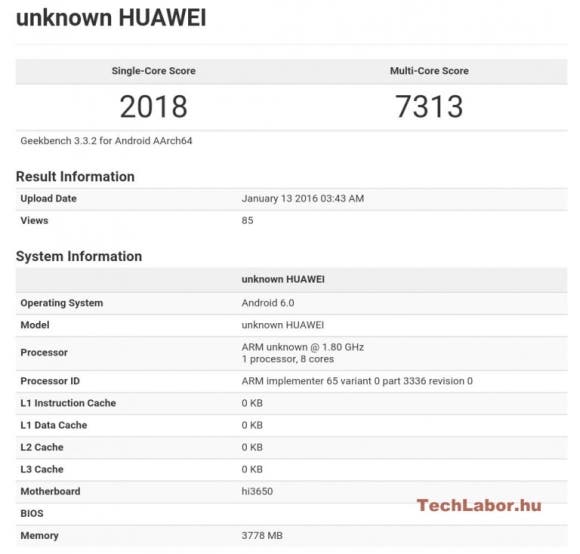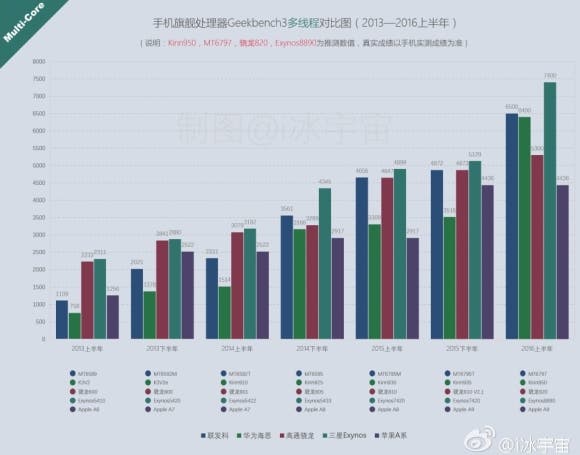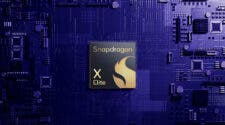As you may already have read, pretty much none of Apple iPhone 6s’ Android counterparts have managed success in challenging the A9 SoC.
According to fresh leaks from China however, it appears as though there finally is an A9 competitor in the making.
The very rumours suggest that the phone in question is the upcoming Huawei P9, which will be powered by the octa-core Kirin 950.

If you aren’t aware, the Kirin 950 is Huawei’s in-house solution that pits itself against the likes of the Apple A9, Exynos 7420 and more.
Leaked images from a benchmark listing show the kind of grunt the Kirin 950 has. It scores 7313 on the multi-core test and 2018 on the single-core test. While the authenticity of these leaks can’t be ascertained at the moment, you’d definitely want the scores to be true.

Coming back to the Kirin 950, the SoC has an octa-core CPU with two clusters of four cores each: 4x Cortex A72 cores @2.3GHz and another four Cortex A53 @1.8GHz.
Besides the Kirin 950, the P9 is expected to feature a 5.2-inch display, Android 6.0 Marshmallow and 4GB of RAM. So it’s quite clearly going to be a handful, the Huawei P9… don’t you think
Follow Gizchina.com on Google News for news and updates in the technology sector.






I don’t know if the comparing of P9 phone with A9 SoC was intentional for the sake of the something-9 format giving it a nice structure, but I think it would have been better to have simply used “Kirin 950” in the title. As it is, it seems an odd editorial choice.
Well said.
I was thinking the exact same thing. Perhaps alluding first to the chipset (Kirin 950) and then to the phone (P9) would have made for a logical comparison while retaining the 9’sy zing.
I actually thought Huawei are naming a new chip P9 kek
same.
The P9 will be the first (and perhaps only) phone to use the 950, so they are one in the same at the moment.
“As you may already have read, pretty much none of Apple iPhone 6s’ Android counterparts have managed success in challenging the A9 SoC.”
What have you been smoking? The A9X is just catching up to the Android counterparts and are already falling behind some SoC.
Apple’s costume CPU’s are more up to Intel mainline contrapart’s. Their is a big difference between native compiled C execution time & ART & Android won’t ever catch it up this way.
Those costume chips and contra scandals point to the Ayatollah eating poisoned cocoa puffs.
This comparation is retarded.
Would call a Kirin 950 as a interesting entry grade high end SoC if HiSilicon got more efforts at DSP. This way it just doesn’t fit anywhere. A CPU alone simply doesn’t make a SoC. Comparing it to anything that really sits in a high end with massive GPU cluster caunt (among everything else) is just retarded.
You know you’ve just hurt the feelings of realjjj
lol
That’s not hard to do. Think we all have done that in the past.
100 different sites go with the same speculation when the obvious guess is that it’s just an overclocked P8.
are the MTK triplets any good ?!
*gets excited!*
Don’t have more info than what’s in the link, first time i hear about these.
37 and 38 must be quads, 37 has LTE cat 4 only and 38 cat 6.
The 6750 must be 8 cores and has cat 6 but given the model it is placed bellow the 6752/6753/6755.
So low mid range and bellow.
No idea what else they bring but maybe the 6738 is interesting, they don’t have a quad P10 so maybe this is that, same process and high clocks but that’s just speculation.
The timing mentioned is Q2 for production so we’ll see those soon enough.
If you want good news TSMC said 16FFC (that’s a lower cost and lower power version of their 16FF) will be ready for volume production in Q1. That means we could see some devices in September or so if any major SoC maker is ready to jump on it fast. Mediatek did say at some point that midrange is going 16nm in the second half of 2016. Ofc it doesn’t have to be Mediatek, could be Qualcomm or Spreadtrum.
TSMC’s bit seems quite exciting ! budget phone makers should pounce at this before anyone else and take a vital initiative with them ! could give us a whole new breed of aptly-priced smartphones with specs to kill for ! could revitalize the budget market !
but this is a worrying howler from MTK … are they going back to powerlessness ?? they should be planning for capable companion SoCs to compliment the upcoming x30 and soon to be common x20 , in devices of a slightly lower pedigree !
You have a distorted image about what the market is. We don’t have final numbers yet but in 2015 they shipped some 400 million smartphone SoCs and just over 150 million were 4G. So what we see as low end is very important for them and they need to properly address that market too. And ofc this news doesn’t mean they don’t have other SoCs this year. Usually they mention some of their future plans during their post quarterly results conference calls. They report Q4 on Feb 1 but don’t expect the press to notice so you would have to tune in yourself.http://www.mediatek.com/en/about/investor-relations/investor-news/mediatek-inc-to-webcast-4q15-result-conference-call-on-february-1-2016/
As for 16FFC , a Sept schedule would be tight ,might end up being in a year from now with ,lets say, P20 or P30 as cut down versions of their X bigger brothers. Maybe some will use it for watches but we really need Google to release the source for Wear before watches can sell. Designing on 16 is costly though, one can’t spend for that unless it is a very high volume product. SD65x does highlight the need for the midrange to go A72 so MTK, Spreadtrum and all the others will need to do that soon – or ofc what follows A72.
And since some are bound to whine about GPU perf i urge them to look at sustained gaming perf for Kirin 950 and it’s Mali T880MP4 , while factoring in screen res http://www.anandtech.com/bench/PhoneTablet14/995
Devices with 1080p – 6S Plus 57.25 FPS , Kirin 950 40FPS, 6 Plus 32FPS, OP 2 not listed there does some 32FPS , HTC M9 with SD810 27FPS, Nexus 5X with SD808 27FPS and OPO with SD801 27FPS . Any hardcore gamer that needs to care about GPU should look beyond short term perf since that doesn’t help them much.
i see. thanks for clearing that up AND the additional info !
1 more thought, we don’t know what cores they use in these 3 SoCs we just assume it would be A53.
However ,it’s not impossible for them to be using A35 – smaller and more efficient but slightly slower than A53. http://www.arm.com/products/processors/cortex-a/cortex-a35-processor.php
A35’s are comparable to the A7’s on it’s int unit wile having the same SIMD NEON block as A53. By all means A35 is more suitable for a third (small dual core) cluster of secure micro always active general purpose cores. HiSilicon actually uses single core calling it Co processor but don’t expect first A35 designs to a merge anytime sooner than late 3Q.
That article says production Q2 and that’s close enough – could be june and first chips shipping in Q3.. And if those SoCs are real they do address a lower end market and it would make sense for them to replace the A7 quads with 3G only with A35 and 4G. Just speculation, remains to be seen what those SoCs offer.
When it comes to lithography we will have a second tire of products based on FD-SOI’s (28, 22 nm.) at late 3Q.
Still wouldn’t compare a quad cluster MALI to same MP 12 contrapart & would love to see that MP12 stacked @400 MHz more than MP4 @ 800~900 MHz.
MP12 is likely overkill and knowing Samsung they’ll clock it way too high. Ofc if the goal is to beat everybody in benchmarks then you can waste die area on a very wide GPU. If the goal is to provide over 30FPS or 30FPS as min framerate in games at a given res , that’s a bit more complicated. With lots of games being rather poor and FPS all over the place. Kirin 950 should actually provide a decent experience in long gaming sessions in actual games at 1080p with just MP4 and that’s not bad at all- it is nice to see this perf from MP4 on 16ff+.
MP8 would be more reasonable i think than MP12 , doubt perf scales much beyond MP8 and hopefully it would be ok for 1440p.
Re think a little bit what are you claiming to be a good optimal design.
A Quad cluster MALI T880 at 900 MHz?
That is still a rather big frequency & considered in desktop GPU area.
Now how about a little math.
I say that a MP12 will drive less energy will delivering more performance no need to go beyond FHD.
The goal is to have a optimal performance when you need it wile retaining power consumption.
Maybe you should read what i said since you seem to be imagining things. If you have difficulties understanding because of your English then, that’s fair , not gonna penalize you for that.
I said MP8 would be good since MP12 would scale little in the given TDP vs MP8. It’s simply not worth spending on the extra area if you don’t gain enough perf and you can gain that perf by optimizing other areas and spending less to get there.
MP4 is ok for gaming at 1080p and that is based on actual FPS ( average and minimum) in actual games on Android.. As for clocks, 850MHz should fit better on 16ff+ but that depends on implementation.
You just want huge GPUs in anything with complete disregard for the financial part, the world doesn’t work like that. It’s a wonder that you don’t want MP16.
I don’t see Huawei is charging less for its Kirin than QC or Samsung for top SoC’s. Midgard simply isn’t the best around GPU architecture & cluster size is to small.
There is a big difference between what I want & what you have in industry. I want a premium experience while retaining green efficiency. Naturally it’s expensive this way but it’s a progress. I also want cheaper price per gate on silicon & thats where 22nm FD-SOI jumps in (20~30%<FinFET).
Would like to see & mid scale FPGA integration soon enough so that we really have cognitive capabilities along with multi purpose acceleration.
I want that a fucking thing become my main computing platform in the future.
Don’t forget to factor in how far down one can scale voltages , especially on a process that is not very mature.
It actually depends on used rooting libs along with cross elements. FD-SOI is much more customizable then FinFET.
Reed:
https://www.google.ba/url?sa=t&source=web&rct=j&url=http://www.st.com/web/en/resource/sales_and_marketing/presentation/technology_presentation/Standard_Cell_White_Paper_20150928.pdf&ved=0ahUKEwiVqqurgr3KAhVH7w4KHfmcAzUQFggbMAA&usg=AFQjCNGXi5xEGsOstLJhglkwLkw8V7AzxA&sig2=fWhpQkExapAmhN_YVd-v7A
The only MP12 is Exynos for now so 14LPP and who’s gonna make a very high end SoC on SOI with the kind of GPU you want. For FD-SOI you got 28nm now and GloFo’s 22 in mid 2017 and it’s fine or great for other things but not very high end mobile .
So back to the topic, can 14LPP do well with MP12 vs MP8? I doubt it but not much public info on the process. Doubt 16ff+ can either ,for now. Huawei for now has rather conservative voltage scaling.
GF 22nm FD-SOI is ready in second half of the year. Honey 22nm FD-SOI is very tunable, I have a feeling you didn’t read the withe paper I sent you. It can be tuned to use up to 50% less energy than first gen 14~16nm FinFET, it can also be tuned to go on pair with it in performance what it stays it’s 20~30% cheaper per gate.
Yes I am for bigger GPU wile respecting a golden rules of margins of power consumption/frequency on silicon.
An T880 MP12 @ 400 MHz is only 10.5% faster then MP4 @ 900 MHz but it will deliver those 10.5% consuming 20% less power & it will consume a lot less in less demanding workloads (when only 2~4 clusters are used).
HiSilicon never had a good power scaling on any up to date SoC they made. Kirin 950 is not an excuse & T880 MP4 is a worst example of silicon rape on any mobile SoC when it comes to GPU up to date.
Now instead of bullshiting future more pleas reed that wite paper.
In 2017 GF will have a 14nm FinFET SOI ready but not publicly & not to other costumes then IBM.
Actually just this week at the FD-SOI Forum, GloFo said that 22nm FDX will be ready for high volume production in mid-2017. – you can google for it and there is no fresher info than that.
Even GloFo isn’t going as far as to claim that FD-SOI is fit for high end smartphone, in fact they always state that it is not. FD-SOI has it’s target markets because of cost and power but not server or high end phones where perf beats power and cost.. If someone tries that, cool , curious how they do it.
“An T880 MP12 @ 400 MHz is only 10.5% faster then MP4”
You mean MP4 at 900 or MP8 at much less since 900 is not doable forMP8 And btw even games like Angry Birds 2 can’t reach 60FPS on current Android devices, point being that the load is pretty much always high.
I wrote exactly what I ment.
FD-SOI is suitable for high end in smartphones it’s not suitable for high end server’s with large amount of DRAM & extreme frequencies.
I don’t read bullshit sources & from all I have read from on industrial specialized blogs (SoC Centrale, DR SoC & cetera) they are redy for full range comercial production at 3Q this year.
Still didn’t read that wite paper!
Won’t argue with kids.
EETimes is legit enough,plus the date was announced as mid 2017 for 22FDX from the start in GloFo’s press release from mid 2015, for very high volume production.
You don’t have the perf for high end, you get better cost for low power but nobody claims high end phone SoCs will fit FD. Hell by mid 2017 it would have to compete with 10nm.
It is.
Well 35% more gates with same cost & same power consumption like second tire of 14~16 nm FinFET with 20% less performance is still step up (15%).
I consider more real usage scenarios where power consumption is crucial & in that area they are compatible to 14~16 nm FinFET. They won’t be compatible to the 10 nm FinFET for that GF is developing 14 nm FinFET SOI but questions is if it will be available to anyone except IBM.